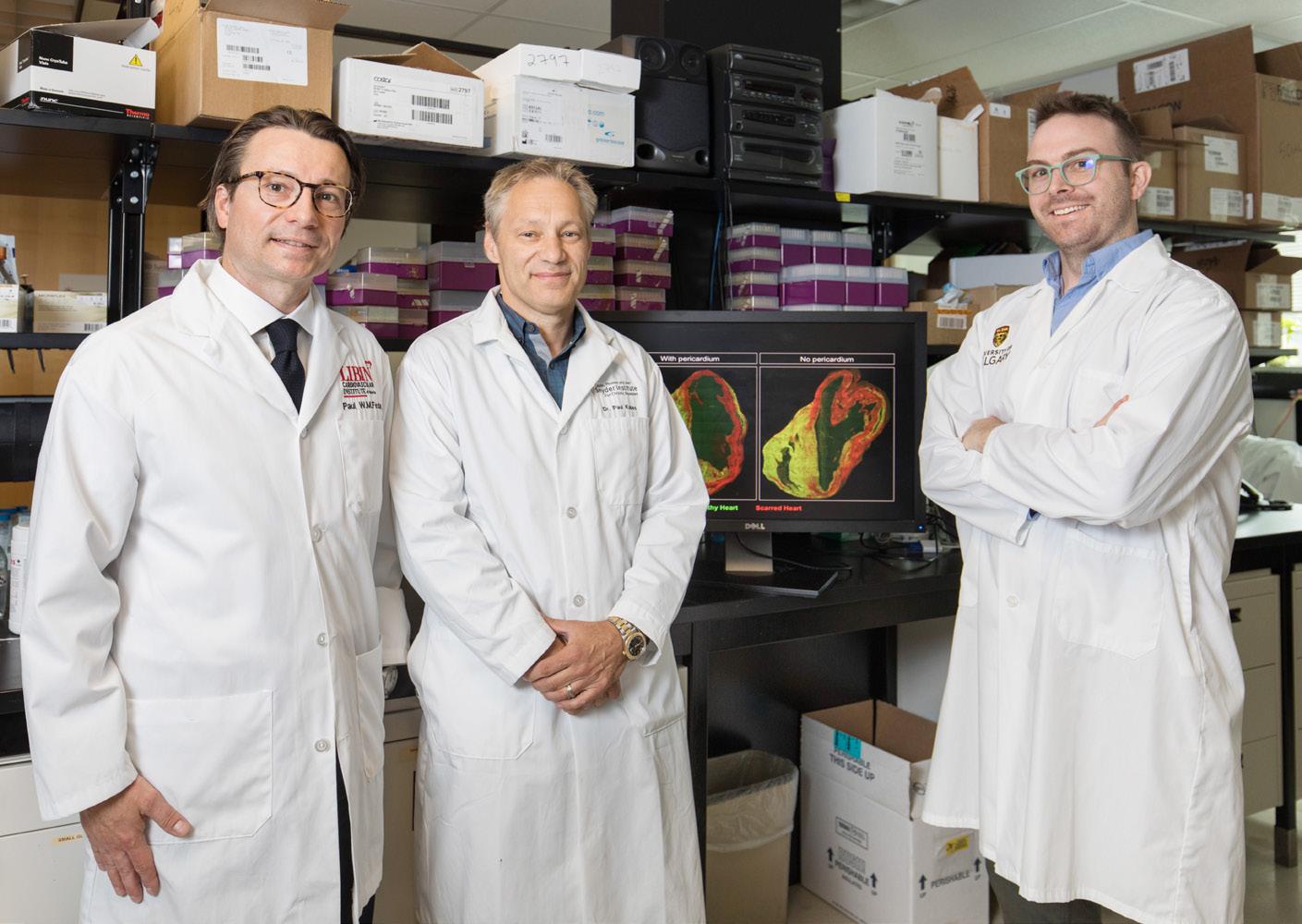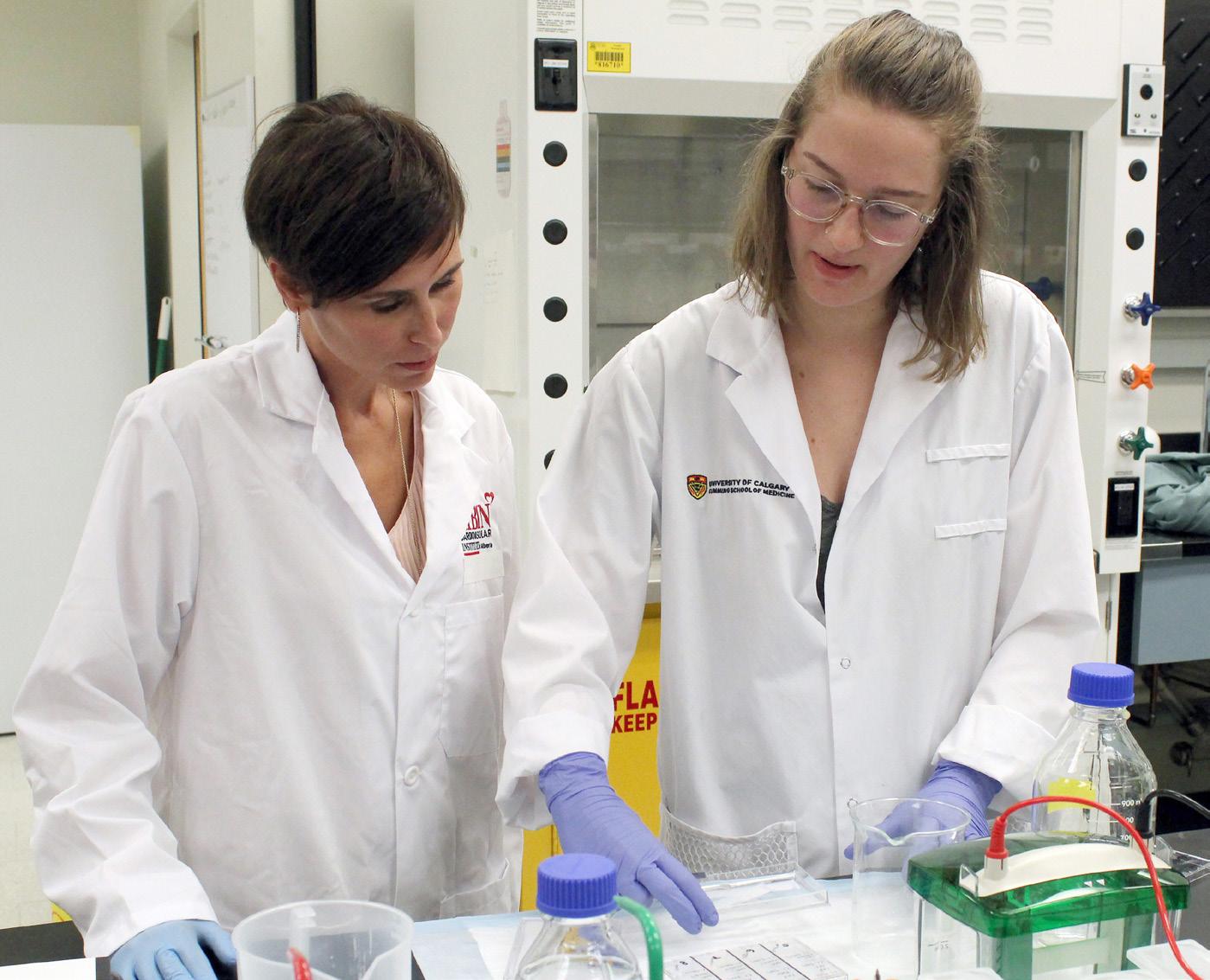
7 minute read
Cell discovered that can heal hearts
from Libin Life 2020
28
Researchers make fundamental scientific discovery that could lead to new ways to repair damaged hearts
Advertisement
By Jordanna Heller & Steve Macfarlane, Cumming School of Medicine
University of Calgary researchers are the first to discover a previously unidentified cell population in the pericardial fluid found inside the sac around the heart.
The discovery could lead to new treatments for patients with injured hearts. The study led by Drs. Paul Kubes, PhD, Justin Deniset, PhD, and Paul Fedak, MD, PhD, was published in the summer of 2019 in the internationally recognized journal Immunity. The Kubes lab, in collaboration with the Fedak lab, found that a specific cell, a Gata6+ pericardial cavity macrophage, helps heal an injured heart in mice. The cell was discovered in the pericardial fluid (sac around the heart) of a mouse with heart injury. Working with Fedak, a cardiac surgeon and director of the Libin Cardiovascular Institute, the team found the same cells within the pericardium of people with injured hearts, confirming that the repair cells offer the promise of a new therapy for patients with heart disease. “The fuel that powered this study is the funding from the Heart and Stroke Foundation of Canada, the collaboration between two major research institutes at CSM (Snyder and Libin) and the important contribution of philanthropy from the Libin and Snyder families to obtain imaging equipment available to very few programs globally,” says Kubes, the director of the Snyder Institute for Chronic Diseases at the Cumming School of Medicine (CSM) and professor in the Department of Physiology and Pharmacology. Heart doctors hadn't explored the possibility that cells just outside the heart could participate in healing and repair of hearts after injury. Unlike other organs, the heart has a very limited capacity to repair itself, which is why heart disease is the No. 1 cause of death in North America.
“Our discovery of a new cell that can help heal injured heart muscle will
LIBIN LIFE
open the door to new therapies and hope for the millions of people who suffer from heart disease," says Fedak, a professor in the Dept. of Cardiac Sciences. "We always knew that the heart sits inside a sac filled with a strange fluid. Now we know that this pericardial fluid is rich with healing cells. These cells may hold the secret to repair and regeneration of new heart muscle. The possibilities for further discovery and innovative new therapies are exciting and important." Working together and bringing expertise across disciplines, the basic researchers working with the cardiac surgeon and researcher, have identified the cell in
LIBIN LIFE
29
Drs. Paul Fedak, MD, PhD, Paul Kubes, PhD, and Justin Deniset, PhD, discovered that a cell in the pericardial fluid surrounding the heart has healing properties that may help repair injured heart muscle. Photo by Adrian Shellard.
less than three years — a relatively quick time frame to move research from the lab and animal models to people. Dr. Justin Deniset, PhD, who is the first author on this study, has worked on this research since it began. “This project stemmed from wanting to integrate my previous research training in cardiovascular disease with my current focus on the immune system within the Kubes laboratory," he says. "The diverse expertise in both areas combined with the state-of-art infrastructure we have here at the CSM made it the ideal setting to undertake such an endeavour. Collaborating with a clinician scientist such as Dr. Fedak provided a different perspective to our research questions and enhanced the impact of our work. This type of partnership also paves the way to explore how to translate our findings from the bench to the clinic, which is ultimately our goal." Next Fedak hopes to recruit a basic scientist to move the research to a broader study of human heart repair. This new program will extend the collaboration between basic and clinical research to find potential new therapeutics to improve heart repair.
Philanthropy fuels research advances
Both the Kubes and Fedak labs have a solid foundation of support from some of UCalgary’s most generous philanthropic partners, including the Snyder, Libin and Campbell families, whose contributions over the years have allowed the researchers to bring in cutting-edge technology and talented trainees to advance their work and make a global impact in health outcomes. “The results are spectacular — a fundamental scientific discovery with enormous clinical relevance. It highlights that supporting any part of the CSM enterprise can result in a significant impact in ways you may not expect,” says Fedak. “I am thankful for the support of these families for strengthening my laboratory and allowing me to successfully collaborate with a world-class scientist from the Snyder Institute. We may have invented a new field of research — immuno-cardiology!” This research is supported by the Heart and Stroke Foundation of Canada, the Canadian Institutes of Health Research, the Canada Research Chairs Program and the National Institutes of Health.
“The results are spectacular — a fundamental scientific discovery with enormous clinical relevance." — Dr. Paul Fedak, MD, PhD
30
LIBIN LIFE
Mentorship matters
Q&A with the Libin’s new education director
We sat down with Dr. Jennifer Thompson, PhD, the Libin Cardiovascular Institute’s new education director, to discuss her views on education and mentors and to hear her plans for the education portfolio at the Institute.
How long have you been an educator?
I began my teaching career while doing postdoctoral studies in the Vascular Biology Center at the Medical College of Georgia at Augusta University. As an adjunct professor, I taught several undergraduate and graduate courses in the Kinesiology Department as well as in the Biological Sciences Department. My teaching experience was a nice complement to my research activities because it put me in a position to have a direct impact on students and help them achieve their potential.
Why is education important to you?
Trainees aren’t just driving the research of today, they will be the principal investigators and leaders of tomorrow. To advance biomedical research in Canada, it is critically important to retain the strongest students and adequately train them to develop internationally competitive research programs.
Why did you agree to take on this role?
I am really excited about taking on the role of education director. I have always been passionate about education and am excited to contribute to the mission of the Libin Institute.
What is your education philosophy?
The biomedical research enterprise has evolved – there are higher expectations for collaborative, interdisciplinary and translational research as well as connecting to the broader community. We need to equip our trainees with the full complement of skills required to be successful in this new landscape. I believe this involves providing multilayered training that extends beyond the laboratory and positions trainees to apply their knowledge and skills to a variety of career trajectories.
LIBIN LIFE
31

Dr. Jennifer Thompson, PhD, works with summer student Victoria Palmgren in her lab at UCalgary’s Foothills Campus. Thompson is the Libin’s new education director.
What does the Institute offer its trainees?
The Libin Institute offers trainees a number of opportunities that foster skills in science communication, critical thinking and networking. Trainees also have the opportunity to be mentored by exceptional scientists within the Institute. For a comprehensive list of what is available, visit libin.ucalgary.ca/research.
What are your goals for education?
Moving forward, I would like to see the Libin Institute diversify its training platform to include broader skills training and career planning. I think students and postdoctoral trainees would benefit from gaining awareness of the full breadth of biomedical careers available to them as research trainees.
What is the ideal education environment?
In the ideal educational environment, students would feel inspired and excited about their contributions to the important research being conducted at the Institute. They would feel connected to the Libin community and confident in their career trajectories.
Why are mentors important?
Mentors – both formal and informal – have had a huge impact on my career and life. One of the most impactful influences in my career is a senior principal investigator from Oregon Health and Sciences University, who is one of the most highly respected researchers in my field. He is admired not only for his influential research, but also for his strong mentorship and support of emerging trainees. Although he has no vested interest in my career, he has long been my advocate and has made a tangible impact on my career opportunities.










